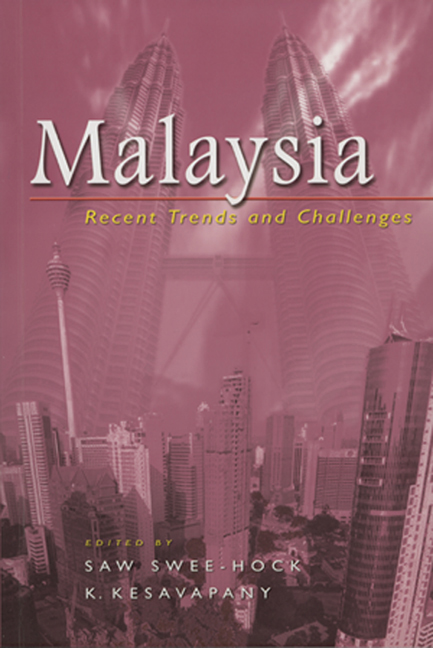Book contents
- Frontmatter
- Content
- Preface
- Foreword
- Contributors
- 1 Population Trends and Patterns in Multiracial Malaysia
- 2 The Emerging Politics of Islam Hadhari
- 3 Bangsa Malaysia: Vision or Spin?
- 4 The 2004 Malaysian General Elections: Economic Development, Electoral Trends, and the Decline of the Opposition
- 5 The UMNO-PAS Struggle: Analysis of PAS's Defeat in 2004
- 6 The Malay Electorate in 2004: Reversing the 1999 Result?
- 7 UMNO and BN in the 2004 Election: The Political Culture of Complex Identities
- 8 Malaysia's Civil Service Reform: Mahathir's Legacies and Abdullah's Challenges
- 9 Reinventing Governance in Corporate Malaysia: The Challenges Ahead
- 10 Globalisation and Ethnic Integration in Malaysian Education
- 11 Globalisation and the Challenges Facing Malaysia's Economy
- 12 Promising Start to Malaysia-Singapore Relations
- Bibliography
- Index
12 - Promising Start to Malaysia-Singapore Relations
Published online by Cambridge University Press: 21 October 2015
- Frontmatter
- Content
- Preface
- Foreword
- Contributors
- 1 Population Trends and Patterns in Multiracial Malaysia
- 2 The Emerging Politics of Islam Hadhari
- 3 Bangsa Malaysia: Vision or Spin?
- 4 The 2004 Malaysian General Elections: Economic Development, Electoral Trends, and the Decline of the Opposition
- 5 The UMNO-PAS Struggle: Analysis of PAS's Defeat in 2004
- 6 The Malay Electorate in 2004: Reversing the 1999 Result?
- 7 UMNO and BN in the 2004 Election: The Political Culture of Complex Identities
- 8 Malaysia's Civil Service Reform: Mahathir's Legacies and Abdullah's Challenges
- 9 Reinventing Governance in Corporate Malaysia: The Challenges Ahead
- 10 Globalisation and Ethnic Integration in Malaysian Education
- 11 Globalisation and the Challenges Facing Malaysia's Economy
- 12 Promising Start to Malaysia-Singapore Relations
- Bibliography
- Index
Summary
Introduction
The period stretching from 1997 to 2002 was one of the most stressful in the short history of relations between Malaysia and Singapore. A number of confrontational issues came to a boil in the mean time, making it all the more difficult for them to be resolved. Some older issues were resurrected, such as the return of CPF contributions to Malaysian workers and railway land and the Tanjong Pagar railway terminus, on which a Points of Agreement (POA) had been signed in 1990. The legality of the POA was subsequently questioned by the Malaysians, making it an issue within an issue. Among the new issues that emerged were the pricing of raw water supplies from Malaysia to Singapore, Singapore military access to Malaysian airspace, a proposal for a new bridge to replace the Causeway, and land reclamation by Singapore in what Malaysia alleged was its territory.
Several attempts to find solutions through negotiations were made at various official levels, including two visits to Kuala Lumpur in 2000 and 2001 by then Senior Minister Lee Kuan Yew. In fact, if Malaysia had stood by its offer of 60 sen per thousand gallons (as stated in then Malaysian Prime Minister Dr Mahathir's letter to SM Lee dated 21 February 2001) a solution could have been reached in the second round of negotiations. Malaysia inexplicably asked for RM3 per thousand gallons. This meant an increase of 100 times more than the existing price of raw water, or in percentage terms a 10,000 per cent increase. Such a demand made it difficult for any common ground to be reached and led to a stalemate in the negotiations.
At about this time, Singapore achieved a strategic breakthrough in its capacity to be self-sufficient in its water requirements. Significant advances in water technologies, together with increase in reservoir capacity, were the contributory factors for this breakthrough. Hereafter, the water issue with Malaysia would be on the basis of “willing seller, willing buyer”.
- Type
- Chapter
- Information
- MalaysiaRecent Trends and Challenges, pp. 275 - 286Publisher: ISEAS–Yusof Ishak InstitutePrint publication year: 2005



